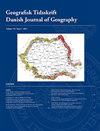Urban transformations, migration and residential mobility patterns in African secondary cities
IF 1.1
4区 社会学
Q4 ENVIRONMENTAL STUDIES
Geografisk Tidsskrift-Danish Journal of Geography
Pub Date : 2017-05-15
DOI:10.1080/00167223.2017.1326159
引用次数: 34
Abstract
Abstract Urban growth is a significant trend in Africa. Scholarly attention and urban planning efforts have focused disproportionately on the challenges of big cities, while small and medium-sized urban settlements are growing most rapidly and house the majority of urban residents. Small towns have received some attention, but very few studies have focused on secondary cities. This paper offers a study of urban transformations, migration and residential mobility patterns in Arusha, a rapidly growing secondary city of Tanzania. Arusha functions as a major attraction for migrants and in-migration is a central dynamic shaping transformation processes in central areas characterized by high population turnovers, vibrant rental markets and widespread landlordism. There is also a considerable degree of intra-urban residential mobility within and between central areas. Intra-urban residential mobility is the most important dynamic shaping transformation processes in peripheral areas characterized by long-term urban residents moving from central parts of the city as part of a process of establishing themselves as homeowners. Overall, the paper provides crucial insights on how migration and residential mobility patterns influence processes of urban growth and transformation in the context of large secondary city, and thereby contributes to fill a significant knowledge gap on secondary cities in Africa.非洲二级城市的城市转型、移徙和居民流动模式
城市增长是非洲的一个重要趋势。学术关注和城市规划工作不成比例地集中在大城市的挑战上,而中小型城市住区增长最为迅速,并容纳了大多数城市居民。小城镇得到了一些关注,但很少有研究关注二级城市。本文对坦桑尼亚快速发展的二级城市阿鲁沙的城市转型、移民和居民流动模式进行了研究。阿鲁沙是对移徙者的主要吸引力,而移徙是中心地区形成转变过程的核心动力,其特点是人口流动率高、租赁市场活跃和普遍存在的房东制。中心地区内部和中心地区之间也存在相当程度的城市内部住宅流动。城市内部居民流动是外围地区最重要的动态塑造转变过程,其特征是长期城市居民从城市中心地区迁移,作为建立自己的房主过程的一部分。总体而言,本文提供了关于大型二级城市背景下移民和居民流动模式如何影响城市增长和转型过程的重要见解,从而有助于填补非洲二级城市的重大知识空白。
本文章由计算机程序翻译,如有差异,请以英文原文为准。
求助全文
约1分钟内获得全文
求助全文
来源期刊
CiteScore
5.20
自引率
0.00%
发文量
5
期刊介绍:
DJG is an interdisciplinary, international journal that publishes peer reviewed research articles on all aspects of geography. Coverage includes such topics as human geography, physical geography, human-environment interactions, Earth Observation, and Geographical Information Science. DJG also welcomes articles which address geographical perspectives of e.g. environmental studies, development studies, planning, landscape ecology and sustainability science. In addition to full-length papers, DJG publishes research notes. The journal has two annual issues. Authors from all parts of the world working within geography or related fields are invited to publish their research in the journal.

 求助内容:
求助内容: 应助结果提醒方式:
应助结果提醒方式:


